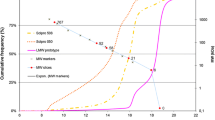Abstract
The surface quality of plywood coated with resin impregnated papers based on tannin/furfuryl alcohol resins was studied. Several hardeners such as hexamine, paraformaldehyde, formurea and a mixture of formurea and paraformaldehyde were added in small quantities to a mimosa tannin/furfuryl alcohol resin. Papers impregnated with resin based on tannin + furfuryl alcohol + paraformaldehyde, or + formurea were found to yield excellent results in standard water vapour resistance and cross-cut tests. Matrix assisted laser desorption ionization time of flight (MALDI-TOF) mass spectrometry and cross-polarisation-magic angle spinning NMR (CP-MAS 13C NMR) were used to show coreaction of tannin with furfuryl alcohol and even furfuryl alcohol self condensation under alkaline conditions, as well as coreaction of formaldehyde-yielding compounds such as hexamine with both tannin aromatic rings and the aromatic ring of furfuryl alcohol. Some of the more important oligomers formed were identified by MALDI-TOF.
Zusammenfassung
Untersucht wurde die Oberflächenqualität von Sperrholz, das mit harzimprägnierten Papieren auf Basis von Tannin/Furfurylalkohol beschichtet worden war. Verschiedene Härter, wie zum Beispiel Hexamin, Paraformaldehyd, Formurea und eine Mischung aus Formurea und Paraformaldehyd wurden in kleinen Mengen dem Mimosatannin/Furfurylalkoholharz zugegeben. Es wurde gezeigt, dass Papiere, die mit Harzen auf Basis von Tannin + Furfurylalkohol + Paraformaldehyd oder + Formurea imprägniert worden waren, ausgezeichnete Ergebnisse bei der Prüfung des Wasserdampfdurchgangswiderstandes und bei Gitterschnittprüfungen erzielten. Mittels MALDI-TOF (matrixunterstützte Laser-Desorptions-Ionisation in Verbindung mit Flugzeitmassenspektrometrie) und CP-MAS 13C NMR (Kreuzpolarisationsverfahren (NMR) mit schneller Probenrotation um den magischen Winkel) wurde eine Koreaktion von Tannin mit Furfurylalkohol und sogar eine Selbstkondensation von Furfurylalkohol unter alkalischen Bedingungen sowie eine Koreaktion von formaldehydfreisetzenden Verbindungen, wie zum Beispiel Hexamin mit sowohl aromatischen Ringen von Tannin als auch dem aromatischen Ring von Furfurylakohol aufgezeigt. Einige der wichtigeren gebildeten Oligomere wurden mittels MALDI-TOF bestimmt.




Similar content being viewed by others
References
Abdullah UH, Pizzi A (2012) Tannin-furfuryl alcohol wood panel adhesives without formaldehyde. Eur J Wood Wood Prod. doi:10.1007/s00107-012-0629-4
Arslan M, Simsek O, Subasi S (2005) Effects of formwork surface materials on concrete lateral pressures. Constr Build Mater 19:319–325
European Norm EN 438-2 (2005). Abrasion resistance
European Norm EN ISO 2409 (2005). Paint and varnishes-cross cut test
Istek A, Aydemir D, Aksu S (2010) The effect of décor paper and resin type on the physical, mechanical, and surface quality properties of particleboards coated with impregnated décor papers. BioResources 5(2):1074–1083
Kandelbauer A, Petek P, Medved S, Pizzi A, Teischinger A (2010) On the performance of a melamine-urea formaldehyde resin for decorative paper coatings. Eur J Wood Prod 68:63–75
Ling Y, Leo KC (2000) Reusing timber formwork: importance of workmen’s efficiency and attitude. Build Environ 35:135–143
Nemli G (2008) Factors affecting some quality properties of the decorative surface overlays. J Mater Process Technol 195:218–223
Nemli G, Usta M (2004) Influence of some manufacturing factors on the important quality properties of melamine-impregnated papers. Build Environ 39:567–570
Pallett PF (2003) Formwork and falsework. Adv Concr Technol 4:3–27
Pasch H, Pizzi A, Rode K (2001) MALDI-TOF mass spectrometry of polyflavanoid tannins. Polymer 42:7531–7539
Pizzi A (1983) Tannin-based wood adhesives. In: Pizzi A (ed) Wood adhesives chemistry and technology. Marcel Dekker, New York
Pizzi A (2008) Chapter 8. In: Gandini A, Belgacem N (eds) Monomers, polymers and composites from renewable resources
Pizzi A, Tondi G, Pasch H, Celzard A (2008) MALDI-TOF Structure determination of complex thermoset networks—polyflavonoid tannin-furanic rigid foams. J Appl Polym Sci 110(3):1451–1456
Pizzi A, Kueny R, Massetau B, Carpentier D, Krebs A, Loiseau F, Molina A, Ragoubi M (2009) High resin content natural matrix-natural fibre biocomposites. Ind Crops Prod 30:235–240
Roberts RJ, Evans PD (2005) Effects of manufacturing variables on surface quality and distribution of melamine formaldehyde resin in paper laminates. Composites Part A 36:95–104
Author information
Authors and Affiliations
Corresponding author
Rights and permissions
About this article
Cite this article
Abdullah, U.H., Pizzi, A., Rode, K. et al. Mimosa tannin resins for impregnated paper overlays. Eur. J. Wood Prod. 71, 153–162 (2013). https://doi.org/10.1007/s00107-012-0652-5
Received:
Published:
Issue Date:
DOI: https://doi.org/10.1007/s00107-012-0652-5




